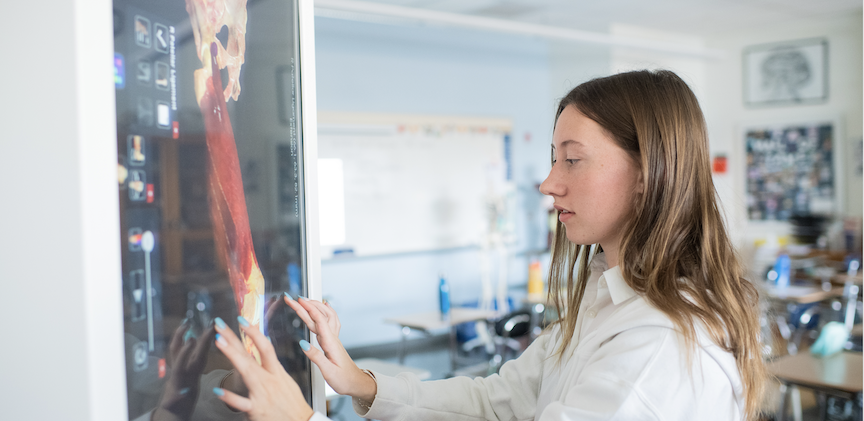
5 minute read
THEN & NOW: The Sciences at EA
“The science faculty were just…cooler,” he recalls with a laugh. “They had the quirkiness of scientists. They were more laid back than the other disciplines, and let students get away with more. I think the students respected that and didn’t take advantage of it.”

Now a microbiologist for the United States Department of Agriculture, Bradd researches the ecology of pathogenic bacteria to prevent these infectious agents from reaching the human population. As a student at EA, he was spending much of his time in Crawford Hill’s '70 biology lab in the Merion campus’s Greville Haslam Science Building.
“There weren’t many science extracurriculars or electives for K-12 students in the 90s aside from AP courses,” explains Bradd. “Instead, Crawford Hill always made time to be available to students to do little, interesting side projects that he’d design based on the unit his class was studying. When we learned about DNA, he made an extra project where we could determine which mock subjects were related by examining their DNA fragments.”

EA’s extracurricular activities and elective offerings have greatly expanded across disciplines since the 1990s, with today’s opportunities in the sciences ranging from clubs like Girls in STEM, regional and state competitions like the Pennsylvania Junior Academy of Science (PJAS), FIRST LEGO League robotics competitions, and electives like Cybersecurity and Astronomy.
Students also have access to scientific thought leaders. Through the Clare Foundation STEM Speakers Series, professionals ranging from astronauts to animators visit campus to speak to students of every passion. For students who would like to explore a scientific topic in much greater depth, The Lilley Fellowship offers the opportunity for students to curate an interdisciplinary project alongside a faculty advisor and later present their findings to their peers. Past science-based project topics included renewable energy, sustainable food systems, and more.
In addition to extracurricular activities, classroom technology has shifted greatly since Bradd’s student years. Students of the 90s studied breakthroughs like gel electrophoresis to separate DNA fragments, as used in Crawford Hill’s DNA side project. They also learned advanced concepts through hands-on wet labs, microscopes, and dissections. Today, classroom technology includes app-controlled temperature, oxygen, and conductivity probes, wireless physics carts with motion detectors, and powerful online resources. And while wet labs and dissections are still conducted, Upper School students can now harness brand-new technology to explore human anatomy through the Anatomage Table. Adopted by many of the world’s leading medical schools and institutions, this giant touchscreen operating table allows for virtual dissection of a lifesize, 3D human body.

Computer science concepts have also become more prevalent in science labs, as the lines between disciplines continue to blur. Pairing science lessons with coding skills taught in EA’s Computer Science and Engineering Department helps prepare students for careers like Bradd’s.

“A lot of people hear the word ‘microbiologist’ and imagine someone in a lab coat running samples, but really, I’m in front of a computer analyzing massive data sets 99 percent of my time every single day, and I can access the data I need from anywhere. That’s where science—at least biology—is headed: the computational aspect of analysis.”
While science labs continue to be transformed by technology and computer science principles, not all of the fun is in the classroom. Whenever possible, science teachers have brought their classes outside to learn about the environment. In the 90s, this meant examining trees on the picturesque Merion campus. Today, this is measuring energy output from exercise, studying soil and the rate of decomposition, or classifying rocks across the Newtown Square campus’s 123 acres.

The environment has taken an even greater role in the sciences over the past few years as the science community grapples with climate change. Following her Lilley Fellowship study on sustainability in the fashion industry, senior Ashley Kim was selected to attend the first Local Conference of Youth climate conference, where she helped draft a letter about the concerns of climate change to be submitted to the Conference of Parties.
Educators are also focused on climate change, according to Stone Family Science Chair Tom Cork. “We have to take [climate change] into account when approaching any science. For example, in chemistry, we must ask if labs and lab waste are sustainable. In biology, we determine how biodiversity loss impacts ecosystems.”
While so much has changed in science instruction over the years, from emerging technologies to the inclusion of computer science to the growing focus on sustainability, the foundation of scientific study has remained the same: Science challenges students to learn about the world around them, and these opportunities are unlocked by gifted teachers.

“A great science teacher is passionate about the subject and gets students to ask questions about their world,” says Tom. “Students with a great science teacher often don't realize they are being guided in this way and experience science learning scientifically—by gathering evidence, supporting their claims, and developing inferences, all with the teacher as a partner in this exciting work.”
“EA’s science teachers made everything interesting and fun,” reminisces Bradd. “Research science is such a niche field, and while none of my EA friends went into the field like I did, all of them had great experiences in the sciences at EA.”






